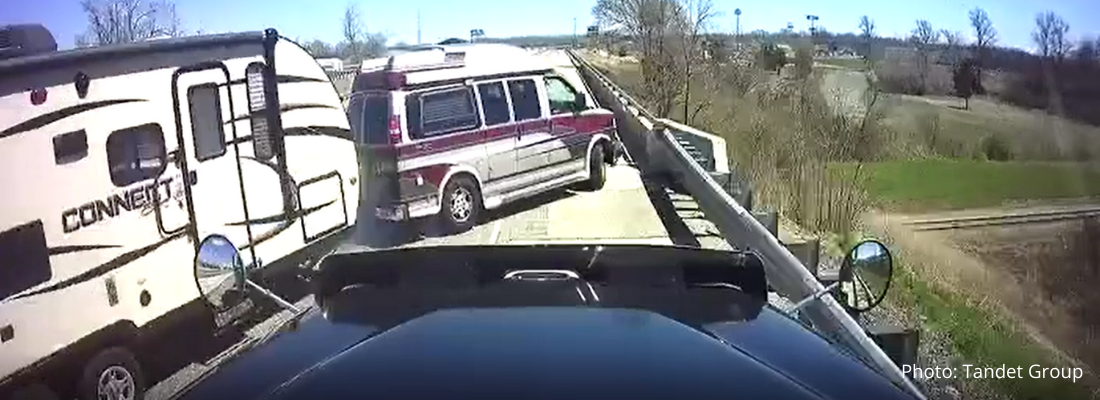A pick-up truck passes you on a country road. A piece flies out of the pickup’s box and hits your truck, leaving visible damage. The pick-up truck continues on its way, leaving you to deal with the problem. How will you explain things to your employer? Will they believe you?
Fortunately, they will, since your dashcam recorded the entire event. You will not be held responsible for the damage to the truck. There are undoubtedly thousands of similar stories out there.
Road incidents are a frequent occurrence, and drivers are at greater risk by virtue of their profession. Using dashcams is beneficial, both to protect drivers and to foster an effective safety culture. In this article, you’ll learn about the types of dashcams and the reasons why you should integrate them to your truck fleet.
How Do Dashboard Cameras Work?
Dashcams, or in-cab cameras, can be pointed at the road or inside the truck cab. Some cameras record continuously, while others pinpoint precisely the few seconds before, during, and after a trigger event, such as an accident, a sharp turn, or hard braking. The best cameras are those that make it easy to access videos related to critical events and continuous recordings as needed.
What Are the Best Dashcams?
Standalone vs. Connected Cameras
Standalone cameras record images on an SD memory card. Older recordings are overwritten based on memory card capacity or recording cycle. With a standalone camera, you have to have the SD card in hand to view videos. That’s not very practical! It means that the truck with the dashboard camera has to be at the terminal for you to access images.
On the other hand, connected dashboard cameras integrated to a fleet management solution offer many benefits. First, you can access recordings at any time. Fleet managers can view all videos remotely. They can even access the video of an event that has just occurred since the camera automatically saves critical events.
You can also be proactive in terms of training and corrective measures. By the time the driver returns to the terminal, memories of the event can start to fade and make it difficult to recall every detail about the problematic situation. With images to put the event in context, it becomes easier to talk things over with your driver.
Capture Events in Their Entirety
Connected cameras make it possible to combine images with the vehicle’s telemetry data for a comprehensive view of the situation. Every video comes with telemetry data, including GPS positioning, vehicle speed, accelerator pedal use, etc. This information supplements the visual evidence to make sense of an event in context in just a few clicks.
Why Use In-cab Cameras?
To Monitor Surroundings
Dashcams make it possible to see the truck’s surroundings, on the road or at a stop. It almost puts you in the driver’s seat. You can see the weather conditions, traffic intensity, and the behavior of other drivers on the road.
To Know the Facts
In 80% of all fatal accidents involving a heavy truck and a car, the truck driver is not at fault. Dashcam video recordings are irrefutable evidence that reveals the context in which accidents occur. They also take a huge weight off drivers’ shoulders, as they don’t have to remember every minute detail right after experiencing a stressful event. Not only do camera images make accident reconstitution easier, but they also protect the driver and the company.
To Protect Against Hit and Runs
Let’s say one of your drivers leaves their truck to pay for fuel inside the truck stop. In the interval, another heavy vehicle collides with your truck. When the driver returns to the truck, they can only survey the damage, which amounts to over $15,000. The person at fault has left the premises without notice. Who foots the bill for the damage? With video evidence in hand, it is easier to identify the driver at fault or the carrier to begin insurance claim procedures.
To Improve Safety
Dashcams help you build and promote a safety culture that is beneficial for your fleet over the long term. Thanks to the recordings triggered by harsh maneuvers, you can watch videos with the drivers involved and engage in open discussions. Drivers will be more likely to change their driving habits and adopt safer behaviors. And by reducing the number of accidents, speeding events and citations, your safety score will increase.
To Lower Insurance Premiums
Cameras are in growing demand by insurance claim services to help determine responsibility in the event of an accident. Their use speaks to a carrier’s commitment to safety culture. The power of video combined with vehicle telemetry data helps mitigate risk and better protect against nuclear verdicts and false statements.
What About Driver-Facing Cameras?
Driver-facing dashcams raise certain questions about privacy. Some carriers choose to use them, while others prefer not to. Before installing cab-facing cameras, you should inquire about applicable privacy laws. Legislation may differ in Canada and the USA.
In Canada, privacy and notification requirements may apply, along with restrictions on collecting, using, disclosing, and storing data. To determine whether driver-facing cameras are justified, courts may examine whether they are the best method to address a legitimate safety issue.
In the United States, employers are not violating any specific law when they require driver-facing cameras. This type of camera is often used in an effort to cut down on driver distraction.
Conclusion
Dashboard cameras are an investment. They offer many benefits and provide a vital safety net. Images pulled from a camera system can help protect your drivers and your company’s reputation. By opting for an integrated solution such as ISAAC InView, you can take advantage of the value of irrefutable data with indisputable video.

